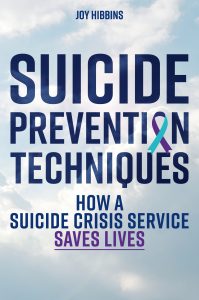 Words by Joy Hibbins, author of Suicide Prevention Techniques.
Words by Joy Hibbins, author of Suicide Prevention Techniques.
It was my own experience of being under mental health services which showed me that there was a need for a different type of crisis care, which would involve using different techniques and strategies from those of the mental health crisis team.
Our team would interact and communicate with clients in an entirely different way. Instead of the clinical distance which I experienced under services, we would openly care for clients, and would demonstrate that this is not incompatible with a professional relationship which has clear boundaries. We build a strong connection with clients, and this is essential when a person is detaching from the people around them, as they approach the point of suicide. However, I explain in the book how we create the boundaries which prevent clients from mistaking the professional relationship for a personal one, and why clients do not become “too attached”, which is what some clinicians have told me they feared.
I realised that it was also important that we altered the power balance between professional and client. When I was under services, I often felt disempowered because professionals made the decisions. Conversely, though, the power seemed to be handed back to me when I was at risk of suicide. If I was assessed as having mental capacity, I was told it was my choice or my decision to end my life.
As a result, I knew it was important to empower and give autonomy to our clients: they decide how often they see us, the kind of support they receive and when they feel ready to leave our service. Under psychiatric services, mental health professionals made those decisions. Clinicians sometimes wonder about the consequences of enabling clients to decide when they leave our service: “Isn’t there a risk that they become too dependent on the service, and stay there for months or even years?” In the book, I explain how this is avoided.
Although we give a significant amount of control to our clients, it is vital that we actively intervene to keep them safe when they are in crisis, whether or not they have the mental capacity to make decisions. We would not tell them that it is their decision to end their life because we deem that they have mental capacity. Our focus is on working tenaciously to help them stay alive throughout the time that they are under our services. We do everything we can for each individual to ensure that they survive.
We have found ways to reach people who are off the radar of other services, by providing the kind of services that even hard-to-reach high-risk men feel able to access; men who are not telling any other service or individual about their risk. In the chapter on “Men and Suicide” I explain why they feel able to come to us when they have ruled out other services.
Having identified that there were sometimes gaps in the current mental health system through which people could fall, we sought to close the gaps, creating a safety net around our clients which would protect them. It became clear that we would need to provide a combination of a Suicide Crisis Centre, home visits and emergency lines to give us more ways to hold them safely. Importantly, we would respond to a crisis wherever it occurred. This has taken us to many unexpected locations, but we need to be wherever the crisis is.
Throughout all this, the lived experience perspective remains at the heart of our work.
The book explains in detail all the different elements required to ensure that every client under our care survives. It is so important that we share this information widely.
 Joy Hibbins is founder and CEO of Suicide Crisis, a registered charity which runs a Suicide Crisis Centre in Cheltenham, UK. Suicide Crisis have a zero suicide achievement and Joy’s book Suicide Prevention Techniques is based on the groundbreaking methods they use. All royalties from sales go towards Suicide Crisis.
Joy Hibbins is founder and CEO of Suicide Crisis, a registered charity which runs a Suicide Crisis Centre in Cheltenham, UK. Suicide Crisis have a zero suicide achievement and Joy’s book Suicide Prevention Techniques is based on the groundbreaking methods they use. All royalties from sales go towards Suicide Crisis.
If you would like to read more articles like this and get the latest news and offers on our mental health books, why not join our mailing list? We can send information by email or post as you prefer. You may also be interested in liking our Social Work, Mental Health and Health Care Facebook page.